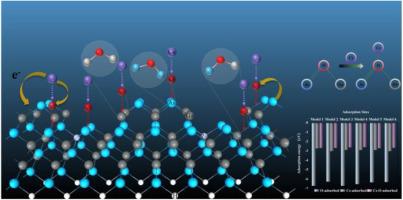First-principles Investigation of Cs Adsorption Behavior at Various Locations on Oxygen-containing GaAs Surfaces
IF 2.4
4区 物理与天体物理
Q3 PHYSICS, CONDENSED MATTER
引用次数: 0
Abstract
First-principles calculations were utilized to analyze O atoms binding at various locations on the GaAs(100)-β2(2 × 4) surface and its impact on Cs adsorption mechanisms. Computational models included oxygen-containing, Cs-adsorbed, and Cs adsorbed oxygen-containing surfaces. The results indicate that deep As-O-As and shallow As-O-Ga structures exhibit the highest adsorption stability based on adsorption energy calculations. Furthermore, the Cs adsorption energy in oxygen-containing models is observed to be marginally higher than that of clean-surface models, suggesting that the presence of O atoms enhances Cs adsorption stability. The deep As-O-As demonstrates the most significant impact on the work function, while the shallow As-O-As yields the lowest work function. This observation implies that the depth of the As-O-As strongly influences its effect on the work function. Notably, for the Ga-O-Ga structure, the difference in work function between Cs adsorbed oxygen-containing surfaces and Cs adsorbed clean surfaces is negligible, indicating that this oxygen-containing configuration has limited impacts on subsequent Cs adsorption. This study discloses that the presence of O atoms promotes charge transfer from Cs atoms and concurrently reduces charge transfer from Cs to the GaAs surface.

含氧GaAs表面不同位置Cs吸附行为的第一性原理研究
利用第一性原理计算分析了GaAs(100)-β2(2 × 4)表面不同位置O原子的结合及其对Cs吸附机理的影响。计算模型包括含氧表面、Cs吸附表面和Cs吸附含氧表面。结果表明,深层As-O-As和浅层As-O-Ga结构具有最高的吸附稳定性。此外,在含氧模型中观察到Cs的吸附能略高于清洁表面模型,这表明O原子的存在增强了Cs的吸附稳定性。深层As-O-As对功函数的影响最大,而浅层As-O-As对功函数的影响最小。这一观察结果表明,As-O-As的深度对其对功函数的影响很大。值得注意的是,对于Ga-O-Ga结构,Cs吸附的含氧表面和Cs吸附的清洁表面之间的功函数差异可以忽略不计,这表明这种含氧结构对后续Cs吸附的影响有限。本研究揭示了O原子的存在促进了Cs原子的电荷转移,同时减少了Cs向GaAs表面的电荷转移。
本文章由计算机程序翻译,如有差异,请以英文原文为准。
求助全文
约1分钟内获得全文
求助全文
来源期刊

Solid State Communications
物理-物理:凝聚态物理
CiteScore
3.40
自引率
4.80%
发文量
287
审稿时长
51 days
期刊介绍:
Solid State Communications is an international medium for the publication of short communications and original research articles on significant developments in condensed matter science, giving scientists immediate access to important, recently completed work. The journal publishes original experimental and theoretical research on the physical and chemical properties of solids and other condensed systems and also on their preparation. The submission of manuscripts reporting research on the basic physics of materials science and devices, as well as of state-of-the-art microstructures and nanostructures, is encouraged.
A coherent quantitative treatment emphasizing new physics is expected rather than a simple accumulation of experimental data. Consistent with these aims, the short communications should be kept concise and short, usually not longer than six printed pages. The number of figures and tables should also be kept to a minimum. Solid State Communications now also welcomes original research articles without length restrictions.
The Fast-Track section of Solid State Communications is the venue for very rapid publication of short communications on significant developments in condensed matter science. The goal is to offer the broad condensed matter community quick and immediate access to publish recently completed papers in research areas that are rapidly evolving and in which there are developments with great potential impact.
 求助内容:
求助内容: 应助结果提醒方式:
应助结果提醒方式:


